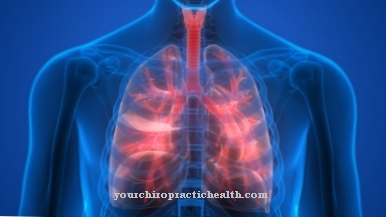As Sinus rhythm the normofrequency and regular human heartbeat is called. This rhythm is formed in the sinus node.
What is Sinus Rhythm?

The sinus rhythm is the normal heart rhythm. The number of heartbeats per minute is called the heart rate or heartbeat rate. In humans, the heartbeat rate depends on the load, age and physical condition.
While the sinus rhythm in the newborn leads to around 120 heartbeats per minute, a person at the age of 70 has a frequency of around 70 beats per minute. The physiological range of the heartbeat frequency and thus also of the sinus rhythm in healthy people is 50 to 100 beats per minute at rest.
The sinus rhythm is formed in the sinus node in the right atrium. The heart consists of two chambers and two atria. The blood reaches the right atrium from the body's circulation and flows from there into the right ventricle. The right ventricle expels the blood into the pulmonary circulation. After being enriched with oxygen, it flows into the left atrium and from there into the left ventricle.
The sinus node is located in the right atrium in the area of the superior vena cava. This area of the mouth of the superior vena cava into the right atrium is called the sinus venarum cavarum. The term knot is misleading. The sinus node is not a visible or palpable node. Rather, the sinus node can be detected electrically. In addition, there is a subtle difference in tissue to the neighboring cells. The sinus node lies close to the epicardium.
The location and size of the sinus node varies greatly depending on the person. The knot can be between 10 and 20 millimeters long and between 2 and 3 millimeters wide. The sinus node is supplied with blood through a branch of the coronary arteries. There is also a collateral supply with other vascular branches. This ensures that the blood supply can be maintained if the coronary artery (part of the coronary arteries) becomes blocked.
Compared to the cells of the working myocardium, the sinus cells have fewer mitochondria and myofibrils. They are therefore less prone to a lack of oxygen.
Function & task
Histologically, the sinus node consists of several specialized heart muscles. In contrast to the other muscle and nerve cells, these have the ability to spontaneously depolarize. During depolarization, the membrane potential on the cell membrane is reduced. In the unexcited state there is a resting potential. During spontaneous depolarization, the voltage-controlled sodium ion channels of the sinus cells open and an action potential is triggered. In healthy people, this happens between 50 and 100 times per minute. Because of the enlarged heart, the sinus rhythm in endurance athletes is often less than 40 excitations per minute.
The excitation that has arisen in the sinus node reaches the atria via the working muscles of the heart. The electrical excitation is conducted to the AV node via so-called internodal bundles. The AV node lies in the Koch triangle in the right atrium. Like the sinus node, it consists of specialized heart muscle cells. The AV node continues into the bundle of His. The bundle of His is also part of the conduction system. It lies below the AV node in the direction of the apex of the heart and merges into the tawara thighs. At the apex of the heart, the two tawara legs split into the Purkinje fibers. These represent the last route of the excitation conduction system and are in direct contact with the heart muscle fibers of the working muscles.
The excitation conduction system is responsible for the contraction of the individual heart muscle cells and thus for the contraction of the entire heart muscle. The excitement spreads downward from the sinus node. As a result, the upper part of the heart contracts minimally sooner than the lower part. This is necessary for proper blood discharge.
The sinus node is connected to the sympathetic and parasympathetic nervous system so that the cardiac output is always adapted to the respective requirements. The sympathetic nervous system develops a positive chronotropic effect on the sinus node. This means that the sinus rhythm is increased. The parasympathetic nervous system, on the other hand, has a negative chronotropic effect, the sinus rhythm decreases.
Illnesses & ailments
From a frequency of 100 per minute, so-called sinus tachycardia is present. In most cases this goes unnoticed. Such sinus tachycardia is physiological in children, adolescents, in stressful or stressful situations.
However, there are also numerous underlying diseases that are associated with sinus tachycardia. This includes, for example, the overactive thyroid (hyperthyroidism). The heart beats faster due to the increased metabolic performance. Sinus tachycardia is also found in circulatory shock, heart failure, fever, anemia and withdrawal from intoxicants.
Pheochromocytoma is also associated with an increased sinus rhythm. Various medications can also increase sinus rhythm. Sinus bradycardia, i.e. a slowed sinus rhythm, is physiological during sleep and in athletes. On the other hand, the causes of pathological sinus bradycardia are tissue damage in the sinus node, the use of medication and increased vagal tone.
The tissue of the sinus node can be damaged by an insufficient supply of oxygen in coronary heart disease (CHD). Infections that lead to myocarditis can also damage the sinus node. The same is true for autoimmune processes. Other causes of sinus bradycardia are hypothyroidism (hypothyroidism), hypothermia (hypothermia), poisoning, increased intracranial pressure and bradycardizing (lowering the heart rate) drugs.
A malfunction of the sinus node can also lead to sick sinus syndrome. The term sick sinus syndrome encompasses various arrhythmias that all originate in the sinus node. The main symptoms of sick sinus syndrome are rapid heartbeat and a slow pulse.



























